
Description
Osteoarthritis is a common condition. It involves deterioration of the surface of a joint. Such deterioration can occur either as a result of an injury, or perhaps just because the joint surface is congenitally poor. There are some people who have a strong family history of arthritis of this type. These people tend to develop problems affecting the knee in particular but often also the hip and sometimes other parts of the body. The essential issue is loss of the structure of the cartilage, which covers the bone. Once the cartridge has lost its structural integrity, it is no longer able to bear weight as it normally does. For this reason, the joint then undergoes a progressive loss of function. The final result is osteoarthritis, a progressive condition.
Presentation
People complain of discomfort, swelling and warmth in the affected joint. The joint is also stiff and becomes stiffer as time passes. As the process becomes more advanced, the degree of involvement of the joint becomes more significant, which leads to greater amounts of pain, swelling, and stiffness. Sometimes deformity develops but often does so very slowly.
Osteoarthritis is a progressive process.

Treatment
In many cases, the matter can be managed without surgery and in this situation, it is often not necessary to see a surgeon. However, as a matter becomes more troublesome and starts to interfere with the enjoyment of life, a surgeon may be consulted.
Non-operative
Analgesia such as panadol, ibuprofen and an anti-inflammatory such as Mobic.
Exercise physiology (EP) and physiotherapy: Often of use to increase strength and to assist with other matters such as general physical fitness, core strength and mobility.

Injection Therapy
There is a limited role for injection therapy. This may include
Cortisone,
PRP (platelet concentrate )
Acupuncture
There is interest in Stem Cell therapy which is at this point an unproven method of treatment.
